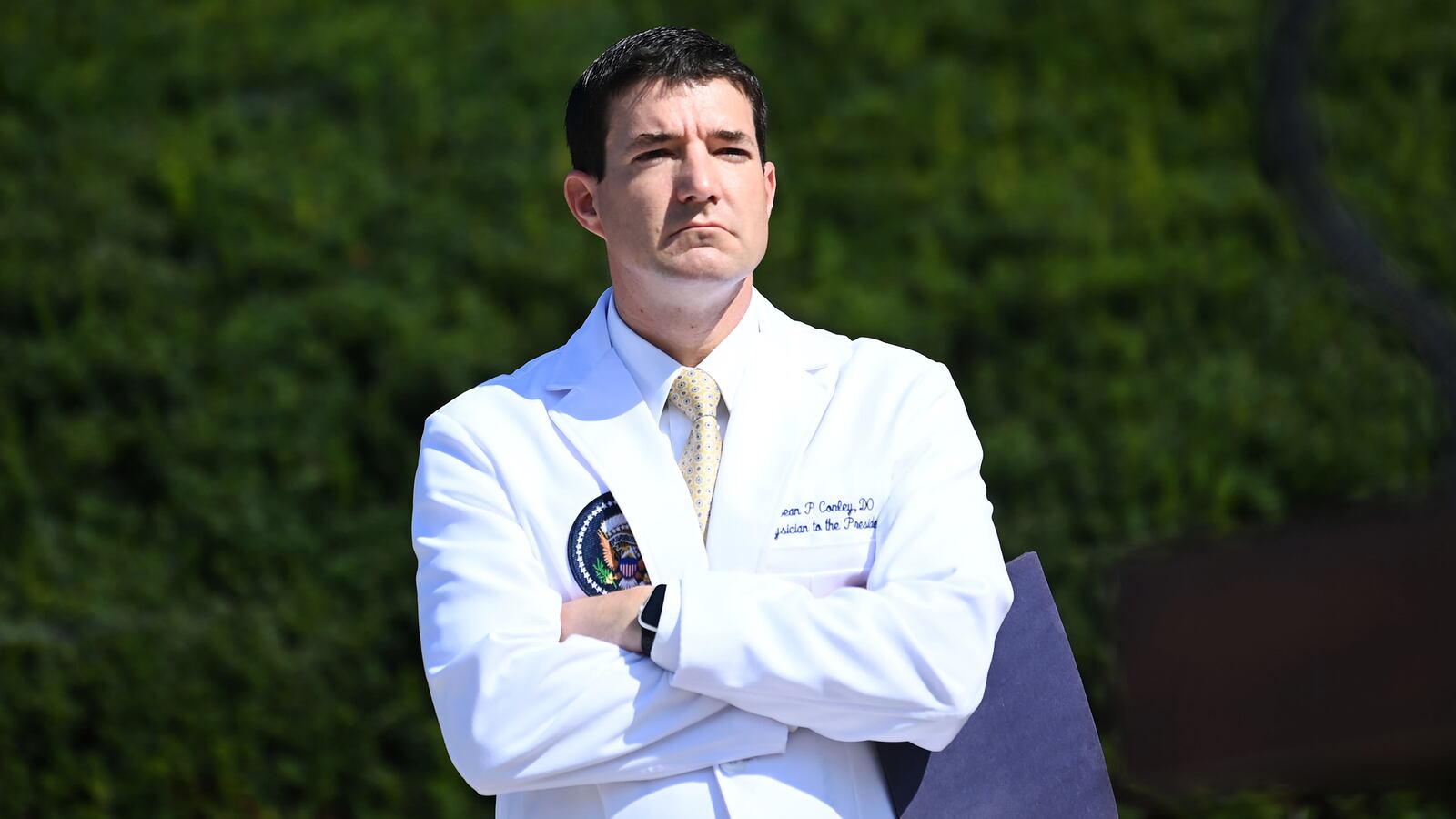President Donald Trump’s head physician admitted to reporters on Sunday morning that he’d kept the knowledge that the president had been administered supplemental oxygen from the public in order to reflect an “upbeat attitude” of Trump’s health as doctors continue to treat his infection with the novel coronavirus.
“I was trying to reflect the upbeat attitude that the team, the president over the course of his illness, has had,” said Dr. Sean Conley during the press briefing, the second Trump’s medical team has given since he was admitted to Walter Reed National Military Medical Center on Friday. “I didn’t want to give any information that might steer the course of illness in another direction, and in doing so, you know, it came off that we were trying to hide something, which wasn’t necessarily true,” Conley said.
Conley had come under heavy criticism following his first health briefing on the president’s condition on Saturday, when he assured the public that Trump was on the mend only for White House Chief of Staff Mark Meadows to tell reporters moments later that Trump was “still not on a clear path to a full recovery,” and when he appeared to dance around questions about whether the president had been provided supplemental oxygen.
“I think his statement was misconstrued,” Conley said of Meadows’ remarks on Saturday. “What he meant is that 24 hours ago, when he and I were checking on the president, that there was that… episode of the high fever and the temporary drop in the oxygen saturation which prompted us to move him up here. Fortunately, that was really a very transient, limited episode.”
The Sunday briefing, however, was marginally more forthcoming. Trump’s medical team told reporters that despite two “transient” drops in blood oxygen levels, Trump “continues to improve” as he is treated for COVID-19, and suggested that he could be discharged as early as Monday.
“Our hope is that we can plan for a discharge as early as tomorrow to the White House,” said Dr. Brian Garibaldi, a pulmonologist and director of the Johns Hopkins Biocontainment Unit. That timeline would put the president ahead of the seven-to-ten day “danger zone” where patients who've appeared to recover have manifested serious symptoms.
Conley also disclosed that Trump is currently receiving dexamethasone, a steroid found to be beneficial to COVID-19 patients on supplemental oxygen and which the World Health Organization recommends only for “severe and critical” COVID-19 cases, in reaction to the two episodes of Trump’s blood oxygen levels dropping into the lower nineties. Conley also said that the president was brought to Walter Reed not out of “an abundance of caution,” as White House press secretary Kayleigh McEnany said on Friday, but because he was “concerned for possible rapid progression” of the president’s illness.
“Late Friday morning when I returned to the bedside, the president had a high fever and his oxygen saturation was transiently dipping below 94 percent,” Conley said. “Given these two developments, I was concerned for possible rapid progression.”
At the time, and over the president’s protests that he didn’t need it, Conley said, he recommended supplemental oxygen to be administered at the White House, and “everyone agreed that the best course of action was to move to Walter Reed for more thorough evaluation and monitoring” of the president’s condition.
Despite Conley’s relative clarity on the timeline of the administration of supplemental oxygen to the 74-year-old president—he told reporters that he would have to check with nursing staff to see if Trump had received oxygen on Saturday—Conley still dodged a series of questions from reporters about the findings of lung scans performed on the president, saying only that there were “some expected findings, but nothing of any major clinical concern.” Conley ignored questions about what those findings were.
Growing national anxiety that the White House has painted an inaccurate picture of Trump’s health spiked on Saturday when Conley had told reporters that the president had tested positive for the novel coronavirus 72 hours prior, only to reverse himself nearly two hours later. The statement left the impression that Trump knowingly had COVID-19 sometime on Wednesday morning—far before the publicly stated timeline that he had been diagnosed late Thursday evening.
“This morning the president is doing very well,” Conley said on Saturday. “Just 72 hours into the diagnosis now. The first week of COVID and in particular Day 7 to 10 are the most critical in determining the likely course of this illness.”
Conley also told reporters that Trump was first treated with the experimental drug Regeneron 48 hours before Saturday, which would put his treatment beginning on Thursday morning—nearly 24 hours before the president’s condition was made public.
Later that afternoon, after a flurry of confusion about the timeline of the president’s illness, Conley issued a “timeline clarification” assuring the public that the president did not knowingly have COVID as he made numerous public appearances.
“I incorrectly used the term ‘72 hours’ instead of ’Day Three’ and '48 hours' instead of ’Day Two,’” Conley wrote in the statement, in which he misspelled the word “Regeneron.”
“The president was first diagnosed with COVID-19 on the evening of Thursday, October 1st,” Conley said.
Moments after Conley’s initial remarks—in which he refused to tell reporters when the president had last tested negative for the virus—the White House sought to clarify. But the official who spoke would only do so anonymously, telling reporters that Conley meant “Day Three” of Trump’s diagnosis, rather than 72 hours, and that Regeneron was administered two days, rather than 48 hours, before.
The conflicting details added to the abundant and growing confusion around Trump’s medical state and how the White House has handled it. Trump was initially described as having mild symptoms and being “very energetic” before being admitted to Walter Reed only hours later, following treatment with Regeneron.






